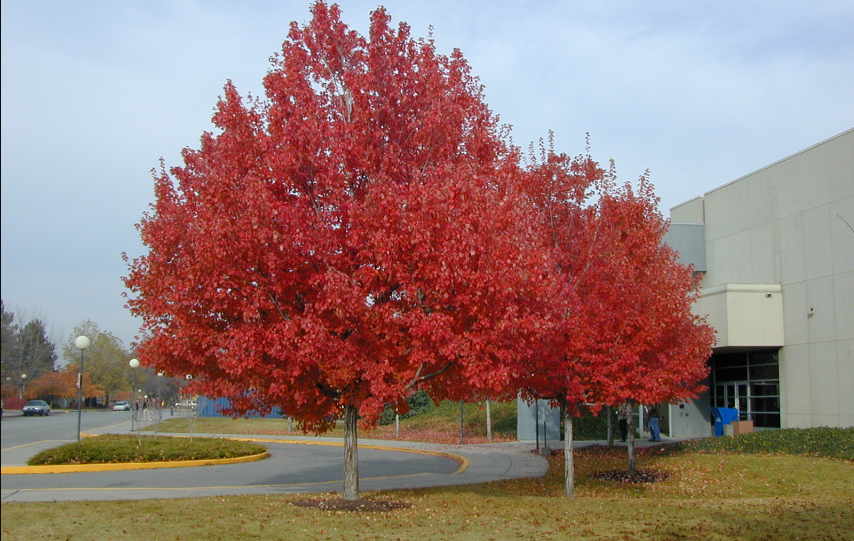
Acer rubrum, the red maple, also known as swamp maple, water maple, or soft maple is a species of maple native to North America, found from southeastern Manitoba around the Lake of the Woods on the border with Ontario and Minnesota, east to Newfoundland, south to Florida, and southwest to East Texas. They are not present in the bottom land forests of the Grain Belt, despite being common in similar habitats and species associations both to the north and south of this area.
The U.S. Forest Service recognizes Red maples as one of the most common and widespread deciduous trees in eastern and central North America, known for their brilliant red foliage in the fall.
These trees are relatively large, growing to a height of 40 to 60 feet, with a width that is typically a bit less than the height. They can live up to 150 years. The leaves are generally 2 to 4 inches in length and width, and are typically 3 lobed, sometimes being 5 lobed with a coarse, serrated edge. The bark is thin and easily damaged by mowers.
Red maples are often confused with the Japanese red maple tree. The Japanese red maple leaves have five to seven “long fingers” that appear more handlike than Acer rubrum. One way to identify red maple trees is by their lobes—usually three to five shorter lobes.
The red maple is a fast-growing tree, averaging about 12 to 18 inches of height per year. They are best grown in soil that has a pH of neutral to acidic in the range of 4.5 to 6.5. They prefer full sun to partial shade and well-drained soil.
There are more than 20 cultivars of red maple trees that differ in fall foliage colors, height, or leaf shape. Some popular cultivars include ‘October Glory’, ‘Autumn Blaze’, and ‘Red Sunset’.
Characteristics of red maples
- Size and Growth Rate: Grow to a height of 40 to 60 feet. They are fast-growing trees, averaging about 12 to 18 inches of height per year.
- Bark: The bark of young trees is smooth and silvery-gray, becoming scaly and dark with age.
- Leaves: Leaves are generally 2 to 4 inches in length and width, and are typically 3 lobed. They turn a vibrant red in the fall.
- Flowers: They’re are one of the first trees to flower in early spring. Small, red flowers in clusters mature in late winter.
- USDA Zones: Generally hardy to USDA zones 4A through 9B.
- Root System: The root system is relatively shallow and non-invasive.
- Lifespan: With proper care, it can live for 50 to 150 years.
- Light Tolerance: Prefer full sun to partial shade.
- Temperature and Humidity: Adaptable to a wide range of temperature and humidity conditions.
- Toxicity: Not considered toxic to humans or animals.
- Water and Soil: Prefer soil that has a pH of neutral to acidic in the range of 4.5 to 6.5. They are tolerant of a wide range of soil conditions and can adapt to various environmental conditions. They prefer well-drained soil.
Varieties/Species of Red Maples
- Swamp Red Maple (Acer rubrum var. rubrum)
- Drummond’s Red Maple (Acer rubrum var. drummondii)
- Tricolor Red Maple (Acer rubrum ‘Tricolor’)
- October Glory Red Maple (Acer rubrum ‘October Glory’)
- Red Sunset Red Maple (Acer rubrum ‘Red Sunset’)
- Armstrong Red Maple (Acer rubrum ‘Armstrong’)
- Autumn Flame Red Maple (Acer rubrum ‘Autumn Flame’)
- Flamethrower Red Maple (Acer rubrum ‘Flamethrower’)
- Brandywine Red Maple (Acer rubrum Brandywine)
- Bloodgood Red Maple (Acer rubrum Blood good)
- Bowhall Red Maple (Acer rubrum Bowhall)
- Redpointe Red Maple (Acer rubrum redpointed)
- Scanlon Red Maple (Acer rubrum Scanlon)
- Schlesinger Red Maple (Acer rubrum Schlesinger)
Common Problems associated With Growing Red Maples
- Structural Issues: It is prone to codominant stems, which can lead to weak unions and increased vulnerability to breakage during storms.
- Insect Infestations: Susceptible to pests such as scale insects, which can stress and weaken the tree by feeding on its sap. These insects can be difficult to manage and can cause significant damage if not addressed.
- Fungal Diseases: Fungal diseases, including anthracnose, which can lead to leaf curling, tan or brown spots, and cankers on the tree. These diseases can cause premature leaf loss and even kill young branches.
- Verticillium Wilt: This is a common problem in red maples, causing the tree to wilt and eventually die. It’s caused by a soil-borne fungus and can be difficult to control once established.
- Poor Soil Conditions: Prefer soil that is acidic and well-drained. They can struggle in soil that is too alkaline or poorly drained, leading to issues such as yellowing leaves and slow growth.
- Invasive Root System: Has fast-growing roots that can be shallow or deep. While this allows them to adapt well, it can also become a problem. These roots can easily crack sidewalks, driveway pavements, and even damage foundations if planted too close to structures.
- Leaf Scorch: In hot climates with intense sunlight, especially during extended dry periods, the leaves can scorch. This manifests as brown or burnt patches on the leaf margins.